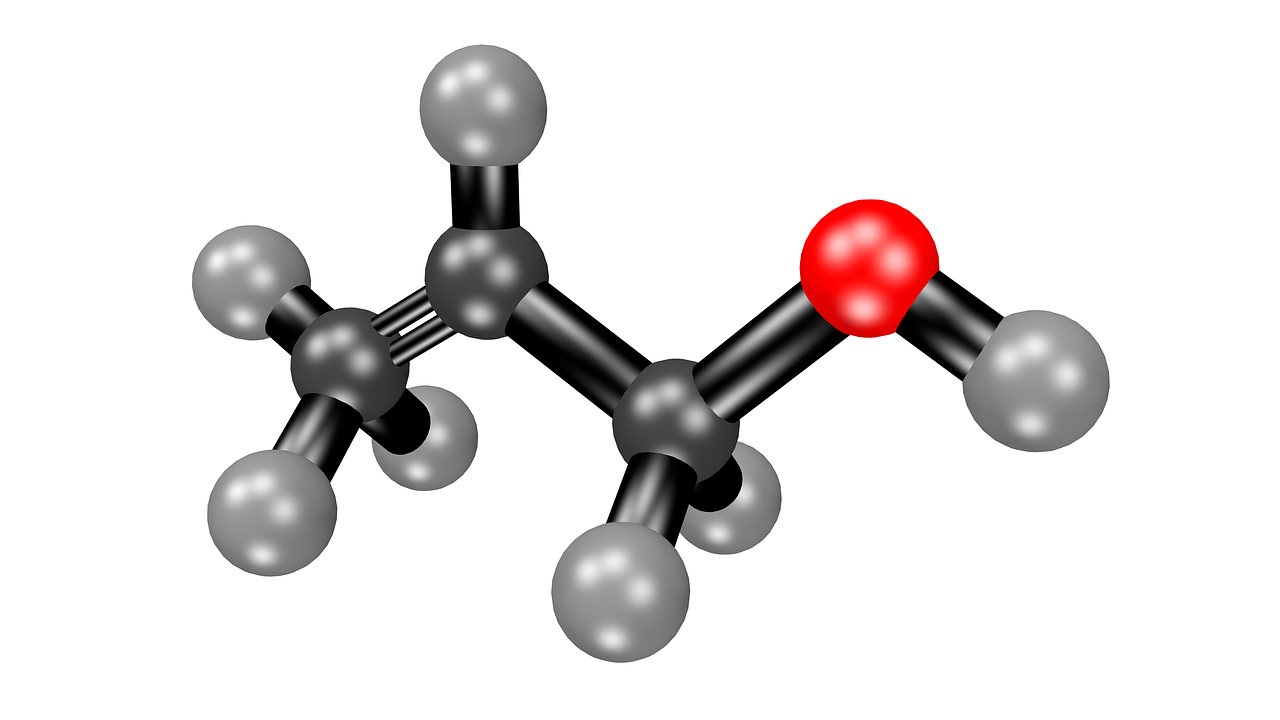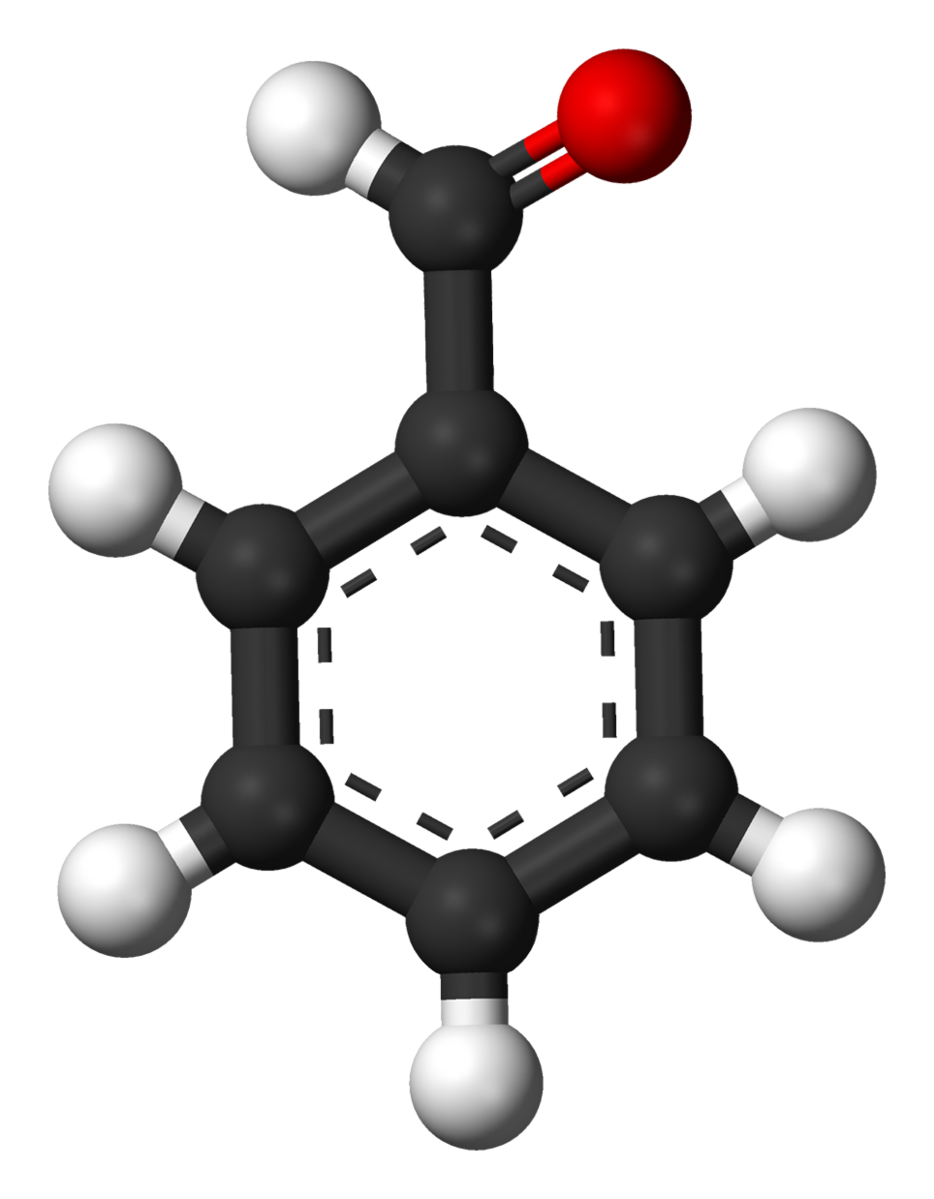Difference Between Acetone and Benzaldehyde
What is Acetone?
Acetone (dimethyl ketone, propanone) is a chemical compound, a colorless, highly flammable, volatile liquid, with a characteristic odor. It is the simplest ketone.
The chemical formula of acetone is C3H6O. Its molecular weight is 58.08 g/mol.
The vapors of the acetone are heavier than air and their density related to air is 2.0 (air = 1). The acetone is less dense than water and its density related to water is 0.8 (water = 1).
Under the recommended storage conditions acetone is a stable compound. Its boiling point is 56°C and its melting point is -95°C. Auto-ignition occurs at 465°C.

Acetone dissolves well in water. It dissolves a number of polar and non-polar organic substances as well as inorganic ones. This property determines one of the most important uses of acetone – as a solvent for varnishes, plastics, adhesives, etc.
Acetone vapors are toxic. They have a narcotic effect and affect the central nervous system.
One of the important peculiarities of the acetone is its ability to accumulate in the body, thereby increasing its concentration. As a final effect of such accumulation, chronic poisoning can occur.
Acetone occurs in the human body, as a breakdown product of fat metabolism. It occurs in plants, animals, vehicle exhaust, volcanic gases, forest fires, etc.
Under normal circumstances, acetone is found in small amounts in the urine and blood. After long-term fasting or diet, the carbohydrate reserve in the body is depleted, the fat is decomposed, which results in the production of acetone and the occurrence of the so-called “acetone breath”.
Acetone occurs in larger amounts in the blood and urine of diabetics. Higher concentrations of acetone in the body result in ketoacidosis, which is one of the symptoms of diabetes.
Acetone is used as a solvent in a variety of organic reactions, as a drying agent, and to precipitate proteins. It is used in medicine and cosmetics, for acne treatments to peel dry skin. It is widely used nail polish remover. Acetone is also used as a food additive – flavoring agent. It is used in the production of paints and coatings. It is often used as a primary component in cleaning agents.

What is Benzaldehyde?
Benzaldehyde is an oily, colorless to yellow liquid with an almond odor. It is an aromatic aldehyde with a single formyl group. It is contained in the stones of bitter almonds, peaches, cherries, etc. It can occasionally be found in human urine.
The chemical formula is of benzaldehyde is C6H5CHO. Its molecular weight is 106.124 g/mol.
The vapors of the benzaldehyde are heavier than air, its vapor density related to air is 3.66 (air = 1). It is slightly denser than water, its density related to water is 1.05 (water = 1).
Benzaldehyde is a reactive liquid and becomes yellowish on keeping. Its boiling point is 178.7°C and its melting point is -57°C. Auto-ignition occurs at 192°C.
Benzaldehyde is insoluble in water and soluble in liquid ammonia.
Benzaldehyde can be harmful if swallowed or inhaled. Prolonged contact with skin can cause skin irritation. Contact with eyes causes serious eye irritation.
Benzaldehyde can be obtained from various natural sources. It is widely used by the chemical industry in the production of flavorings, pharmaceuticals, and perfumes. It is also used in the preparation of different aniline dyes, in water treatment, and in the production of fuels and fuel additives.
Difference Between Acetone and Benzaldehyde
Definition
Acetone: Acetone is a chemical compound, a colorless, highly flammable, volatile liquid, with a characteristic odor. It is the simplest ketone.
Benzaldehyde: Benzaldehyde is an oily, colorless to yellow liquid with an almond odor. It is an aromatic aldehyde with a single formyl group.
Chemical Formula
Acetone: The chemical formula of acetone is C3H6O.
Benzaldehyde: The chemical formula is of benzaldehyde is C6H5CHO.
Molecular Weight
Acetone: The molecular weight of acetone is 58.08 g/mol.
Benzaldehyde: The molecular weight of benzaldehyde is 106.124 g/mol.
Vapors
Acetone: The vapors of the acetone are heavier than air and their density related to air is 2.0 (air = 1).
Benzaldehyde: The vapors of the benzaldehyde are heavier than air, their density related to air is 3.66 (air = 1).
Density
Acetone: The acetone is less dense than water and its density related to water is 0.8 (water = 1).
Benzaldehyde: The benzaldehyde is slightly denser than water, its density related to water is 1.05 (water = 1).
Stability
Acetone: Under the recommended storage conditions acetone is a stable compound.
Benzaldehyde: Benzaldehyde is a reactive liquid and becomes yellowish on keeping.
Boiling Point
Acetone: The boiling point of acetone is 56°C.
Benzaldehyde: The boiling point of benzaldehyde is 178.7°C.
Melting Point
Acetone: The melting point of acetone is -95°C.
Benzaldehyde: The melting point of benzaldehyde is -57°C.
Auto-Ignition
Acetone: The auto-ignition of acetone occurs at 465°C.
Benzaldehyde: The auto-ignition of benzaldehyde occurs at 192°C.
Solubility
Acetone: Acetone dissolves well in water.
Benzaldehyde: Benzaldehyde is insoluble in water and soluble in liquid ammonia.
Hazards
Acetone: Acetone vapors are toxic. They have a narcotic effect and affect the central nervous system. One of the important peculiarities of the acetone is its ability to accumulate in the body, thereby increasing its concentration. As a final effect of such accumulation, chronic poisoning can occur.
Benzaldehyde: Benzaldehyde can be harmful if swallowed or inhaled. Prolonged contact with skin can cause skin irritation. Contact with eyes causes serious eye irritation.
Occurrence
Acetone: Acetone occurs in the human body, as a breakdown product of fat metabolism. It occurs in plants, animals, vehicle exhaust, volcanic gases, forest fires, etc.
Benzaldehyde: Benzaldehyde is contained in the stones of bitter almonds, peaches, cherries, etc. It can occasionally be found in human urine.
Use
Acetone: Acetone is used as a solvent in a variety of organic reactions, as a drying agent, to precipitate proteins, as a flavoring agent, in the production of paints, coatings, cleaning agents. It is also used in medicine and cosmetics.
Benzaldehyde: Benzaldehyde is used by the chemical industry in the production of flavorings, pharmaceuticals, and perfumes. It is also used in the preparation of different aniline dyes, in water treatment, and in the production of fuels and fuel additives.
Acetone verses Benzaldehyde: Comparison Chart

Summary of Acetone vs. Benzaldehyde
- Acetone is a chemical compound, a colorless, highly flammable, volatile liquid, with a characteristic odor. It is the simplest ketone.
- Benzaldehyde is an oily, colorless to yellow liquid with an almond odor. It is an aromatic aldehyde with a single formyl group.
- The chemical formula of acetone is C3H6O, and the chemical formula is of benzaldehyde is C6H5CHO.
- The molecular weight of acetone is 58.08 g/mol, while the molecular weight of benzaldehyde is 106.124 g/mol.
- The vapors of the acetone are heavier than air and their density related to air is 2.0. The vapors of the benzaldehyde are also heavier than air, and their density related to air is 3.66 (air = 1).
- The acetone’s density related to water is 0.8, the benzaldehyde’s density related to water is 1.05 (water = 1).
- Under the recommended storage conditions acetone is a stable compound. Benzaldehyde is a reactive liquid and becomes yellowish on keeping.
- The boiling point of acetone is 56°C. The boiling point of benzaldehyde is 178.7°C.
- The melting point of acetone is -95°C. The melting point of benzaldehyde is -57°C.
- The auto-ignition of acetone occurs at 465°C, while the auto-ignition of benzaldehyde occurs at 192°C.
- Acetone dissolves well in water. Benzaldehyde is insoluble in water and is soluble in liquid ammonia.
- Acetone vapors are toxic and affect the central nervous system. Benzaldehyde can be harmful if swallowed or inhaled. Prolonged contact with skin can cause skin irritation.
- Acetone occurs in the human body, as a breakdown product of fat metabolism. It occurs in plants, animals, vehicle exhaust, volcanic gases, forest fires, etc. Benzaldehyde is contained in the stones of bitter almonds, peaches, cherries, etc. It can occasionally be found in human urine.
- Acetone is used as a solvent in a variety of organic reactions, as a drying agent, to precipitate proteins, as a flavoring agent, in the production of paints, coatings, cleaning agents. It is also used in medicine and cosmetics. Benzaldehyde is used by the chemical industry in the production of flavorings, pharmaceuticals, and perfumes. It is also used in the preparation of different aniline dyes, in water treatment, and in the production of fuels and fuel additives.
- Difference Between Gallstones and Cholecystitis - September 5, 2021
- Difference Between Constipation and Cramping - August 4, 2021
- Difference Between Whole Genome Sequencing and Microarray - May 6, 2021
Search DifferenceBetween.net :
Leave a Response
References :
[0]Housecroft, Catherine and Sharpe, Alan. Inorganic Chemistry. London: Pearson Education Limited. 2012. Print.
[1]Hoffman, R.. Organic Chemistry (2nd Edition). Hoboken: John Wiley & Sons, Inc. 2004. Print.
[2]Petrov, G. Organic Chemistry. Sofia: Kliment Ohridski. 2006. Print.
[3]Image credit: https://en.wikipedia.org/wiki/File:Benzaldehyde-3D-balls-B.png
[4]Image credit: https://pixabay.com/illustrations/acetone-molecule-structural-formula-1094989/
